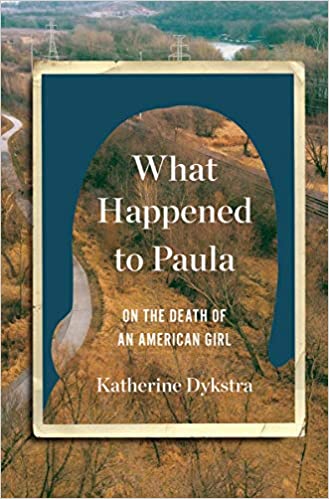Review by Vicki Mayk
 More than 50 years ago, a ten-year-old girl named Mary Ann Verdecchia disappeared in my hometown of Pittsburgh. It became the coldest of cold cases: She was never found. To this day, I remember her name.
More than 50 years ago, a ten-year-old girl named Mary Ann Verdecchia disappeared in my hometown of Pittsburgh. It became the coldest of cold cases: She was never found. To this day, I remember her name.
That memory may have been what drew me to Katherine Dykstra’s book What Happened to Paula: On The Death of An American Girl (W.W. Norton & Co., 2021). The disappearance of girls and women in America is so common, it almost has become a trope. In Dykstra’s book, 18-year-old Paula Oberbroeckling leaves her house in Cedar Rapids, Iowa, late one night in July 1970. Four months later, her body is found in the mouth of a culvert overlooking the Cedar River. Fifty-one years later, the case remains unsolved.
A small notation near the bar code on the book’s cover classifies it as “true crime.” But in journalist Dykstra’s capable hands, it becomes much more. Using Paula’s story as a jumping off point, she examines evolving attitudes about the roles women are forced to assume in American society. The book explores female sexuality, abortion rights and violence against women. Dykstra also deftly uses the story of Paula Oberbroeckling to recall her own coming-of-age and compares that experience to those of women in previous generations, including Paula’s mother as well as her own mother and grandmother. Among those women, being a teenage runaway, surviving parental and spousal abuse and life as a divorced, single parent are recurring themes.
Dykstra is introduced to Paula’s story by her mother-in-law, novelist Susan Taylor Chehak, a Cedar Rapids native who had unsuccessfully tried to make a documentary about the dead girl. At first reluctant, Dykstra becomes quietly obsessed with Paula’s fate – particularly when confronted with the initial indifference of the Cedar Rapids Police Department when her family first reports her missing. Dismissing her disappearance as “just another teenage girl running away,” they are slow to act. It took four days for investigators to make their first inquiries into her disappearance. A recurring theme – that female life is undervalued – emerges. As Dykstra writes about her search for answers, she eventually reaches this conclusion: “Maybe this wasn’t a mystery about one woman’s life and why one woman died but the mystery of why women die.”
The book chronicles the more than six years that Dykstra, often accompanied by her mother-in-law, researched the case, trying to answer the question posed by the book’s title. Her research and reporting are thorough and meticulous. Through interviews with Paula’s mother, her sister, two former boyfriends, police and many friends and acquaintances, she creates a portrait of a strikingly beautiful young woman who also defied societal norms.
In her senior year of high school, just months before her death, Paula moved out of her mother’s house and into her own apartment because of a rift between mother and daughter over Paula’s relationship with Robert, a Black classmate. Dykstra takes the time to provide details about race relations in Cedar Rapids and in Paula’s high school to give valuable context about the relationship. It also allows her to introduce the ways that a woman involved in a mixed-race relationship often becomes devalued by the larger society, underscoring racism and sexism. By the time of Paula’s disappearance, she has left Robert and taken up with Lonnie, who is white, drives a flashy car and seems to have no focus in life. He’s among the last to have seen her alive. Multiple sources interviewed by Dykstra speculate that she may have been pregnant by one of the two men — a fact that could not be confirmed by the time her decomposed body was discovered.
Out of the many theories about what happened to Paula, one of the most plausible is that she was the victim of a botched abortion. Dykstra recounts stories of the men involved in providing illegal abortions in Cedar Rapids in the years preceding the legalization of abortion via the Supreme Court ruling in Roe v Wade. One man, Joe Abodeely, was not a doctor. One who was – Dr. Tom Sturgeon – was performing dangerous procedures in his wife’s beauty salon or in basements, not in his medical office. When Dykstra is contacted by a woman who went to Sturgeon for an abortion, the details she provides make a strong case that Paula may have died from an abortion gone wrong. On the night of her death, she may have been hemorrhaging and seeking medical care. The details Dykstra shares about the way illegal abortions were performed are even more chilling when read following news of recent laws passed limiting abortion access in Texas.
Dykstra writes compellingly about attitudes toward women engaging in premarital sex, making a case that society seeks to punish women for embracing their sexuality. She uses examples from her own life, her mother-in-law’s life, as well as that of her mother and grandmother, to draw parallels about these issues across the generations. The result is an interesting look at the way women’s issues have and have not evolved. Dykstra also is careful to note cases where race or privilege affect women’s experiences.
Dykstra’s writing is clear and conversational, and when she brings herself into the narrative, it’s as if she’s talking to the reader over a cup of coffee. Early in the book, when Dykstra digresses from writing about Paula’s case to talk about her own mother and grandmother, the change in the narrative structure was occasionally confusing. I had to think carefully about who she was talking about now and to recall what she had written about them earlier. But about halfway through the book, I felt that she hit her stride. Or perhaps I had become familiar enough with the many characters. These parallel narratives became more seamless and exploring intergenerational similarities and differences added a great deal to the book, elevating it above standard true crime fare. In the end, the overriding message of What Happened to Paula is that what happened to her could happen to any of us. It is what makes this narrative nonfiction book one that is worth reading.

Vicki Mayk
Reviews EditorVicki Mayk is a memoirist, nonfiction writer and magazine editor who has enjoyed a 40-year career in journalism and public relations. Her nonfiction book, Growing Up On the Gridiron: Football, Friendship, and the Tragic Life of Owen Thomas (Beacon Press) was published in September 2020. Her creative nonfiction has been published in Hippocampus Magazine, Literary Mama, The Manifest-Station and in the anthology Air, published by Books by Hippocampus. She’s been the editor of three university magazines, most recently at Wilkes University in Wilkes-Barre, Pa., and now freelances and teaches adult writing workshops. Connect with her at vickimayk.com.


